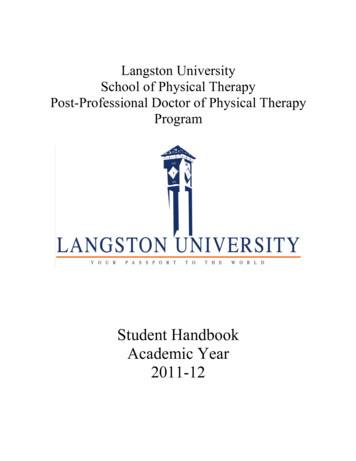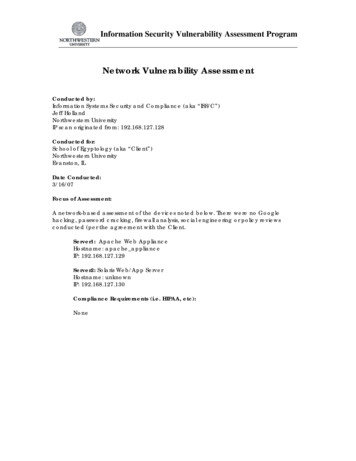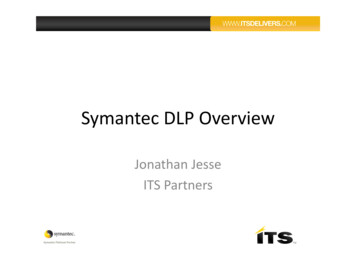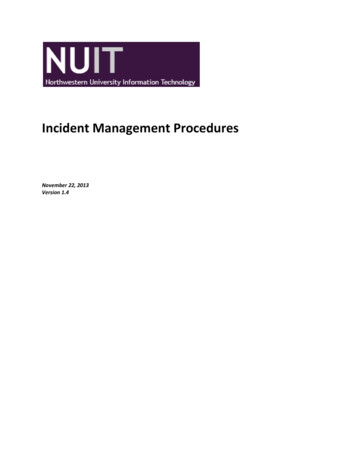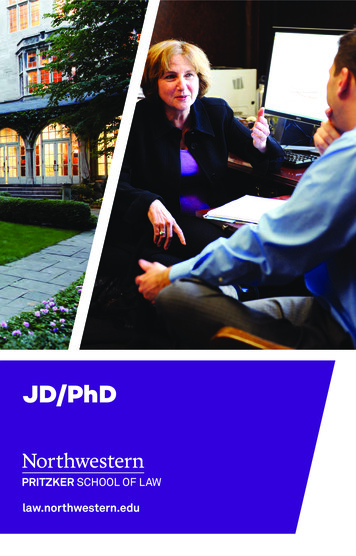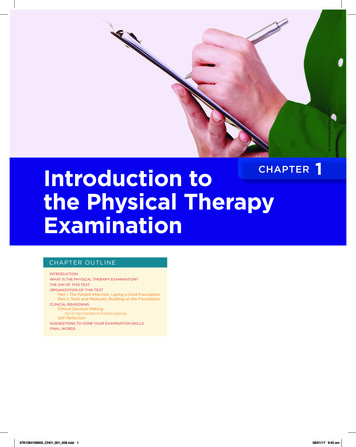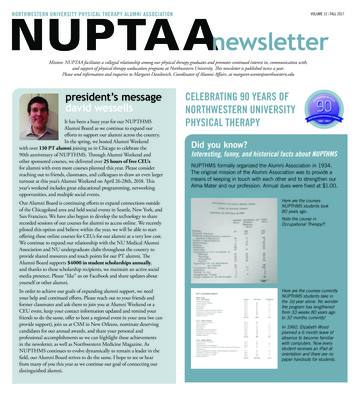
Transcription
NUPTAAnewsletterNORTHWESTERN UNIVERSITY PHYSICAL THERAPY ALUMNI ASSOCIATIONVOLUME 13 FALL 2017Mission: NUPTAA facilitates a collegial relationship among our physical therapy graduates and promotes continued interest in, communication with,and support of physical therapy weducation programs at Northwestern University. This newsletter is published twice a year.Please send information and inquiries to Margaret Danilovich, Coordinator of Alumni Affairs, at margaret-wente@northwestern.edupresident’s messagedavid wessellsIt has been a busy year for our NUPTHMSAlumni Board as we continue to expand ourefforts to support our alumni across the country.In the spring, we hosted Alumni Weekendwith over 130 PT alumni joining us in Chicago to celebrate the90th anniversary of NUPTHMS. Through Alumni Weekend andother sponsored courses, we delivered over 25 hours of free CEUsfor alumni with even more courses planned this year. Please considerreaching out to friends, classmates, and colleagues to draw an even largerturnout at this year’s Alumni Weekend on April 26-28th, 2018. Thisyear’s weekend includes great educational programming, networkingopportunities, and multiple social events.CELEBRATING 90 YEARS OFNORTHWESTERN UNIVERSITYPHYSICAL THERAPYDid you know?Interesting, funny, and historical facts about NUPTHMSNUPTHMS formally organized the Alumni Association in 1934.The original mission of the Alumni Association was to provide ameans of keeping in touch with each other and to strengthen ourAlma Mater and our profession. Annual dues were fixed at 1.00.Our Alumni Board is continuing efforts to expand connections outsideof the Chicagoland area and held social events in Seattle, New York, andSan Francisco. We have also begun to develop the technology to sharerecorded sessions of our courses for alumni to access online. We recentlypiloted this option and believe within the year, we will be able to startoffering these online courses for CEUs for our alumni at a very low cost.We continue to expand our relationship with the NU Medical AlumniAssociation and NU undergraduate clubs throughout the country toprovide shared resources and touch points for our PT alumni. TheAlumni Board supports 4000 in student scholarships annually,and thanks to these scholarship recipients, we maintain an active socialmedia presence. Please “like” us on Facebook and share updates aboutyourself or other alumni.Here are the coursesNUPTHMS students took80 years ago.In order to achieve our goals of expanding alumni support, we needyour help and continued efforts. Please reach out to your friends andformer classmates and ask them to join you at Alumni Weekend or aCEU event, keep your contact information updated and remind yourfriends to do the same, offer to host a regional event in your area (we canprovide support), join us at CSM in New Orleans, nominate deservingcandidates for our annual awards, and share your personal andprofessional accomplishments so we can highlight these achievementsin the newsletter, as well as Northwestern Medicine Magazine. AsNUPTHMS continues to evolve dynamically to remain a leader in thefield, our Alumni Board strives to do the same. I hope to see or hearfrom many of you this year as we continue our goal of connecting ourdistinguished alumni.Here are the courses currentlyNUPTHMS students take inthe 1st year alone. No wonderthe program has lengthenedfrom 33 weeks 80 years agoto 32 months currently!Note the course inOccupational Therapy?!In 1960, Elizabeth Woodplanned a 6 month leave ofabsence to become familiarwith computers. Now everystudent receives an iPad atorientation and there are nopaper handouts for students.
department chair’smessagejules dewaldAs I reflect on my 10 years as department chairand 90 years of Northwestern Physical Therapy, Iam proud of the innovations, leaders, and excellentclinicians who have emerged from our program during these nine decades.It is my privilege to share our achievements from the last academic year.1 NIH U01 (Corcos)1 NIH NRSA F31 fellowship (Karbasforoushan/Dewald)When I started as chair, our program occupied the 7th and 11thfloors of 645 N. Michigan. This year, we are completing constructionon the 8th floor to provide a new student lounge, additional facultyoffices and research laboratory space. In 2017, our program will behoused on the 7th, 8th, 10th, and 11th floor of the building.EducationWe are the 6th ranked physical therapy program in the nation. Our classsizes have expanded to more than 90 students per class, yet we maintainan average incoming class GPA of 3.6. In our graduate programs, wehave increased from 8 graduate students in 2007 to 28 in 2017. Wehave 4 DPT-PhD in engineering students, 10 PhD in biomedicalengineering students, and 14 PhD students in neuroscience (NUIN)with a movement and rehabilitation science (MRS) specialization.ResearchOur total grant income has been increasing from 2.12 million in2012 to 3.0 million in 2017. We are currently in the top 5 of PTschools in the US with regards to research grant income and it isexpected, given the expansion of successful junior investigators,that we may rise to the very top over the next 5 years.Current grants awarded to NUPTHMS faculty are:5 NIH R01s (2 Dewald, 1 Corcos, Elliott, Heckman)4 NIH R01 subcontracts (2 Corcos, Heckman, Huber)1 NIH T32 training grant for graduate students (DPT-PhD)1 NIH K12 scholar development grant funding 6 youngfaculty scholars (5 year renewal starting 9/1/17)4 Clinical Trial studies (Krosschell)1 NIH T15 subcontract for workshop on grant writing (Corcos)We continue to make tremendous strides in clinical practice with ourorthopaedic and neurologic residency partnerships with the ShirleyRyan AbilityLab (formerly the Rehabilitation Institute of Chicago).Our DPT students are engaged in community service providingphysical therapy care to individuals across the Chicagoland area. Ourfaculty are active in teaching and presenting research results across theglobe. In the coming year, I hope to maintain the excellence of ourpast and continue to expand our national and international reach.1 Research Retirement Foundation award (Danilovich)I continue to be impressed by the deep connection that alumni havewith NUPTHMS. Your commitment to this program strengthensour presence around the world. To those of you who have offeredyour time, your service through clinical education, and financialsupport, I thank you for your dedication to NUPTHMS. Yourefforts help achieve our mission and strengthen our visibility andimpact on the physical therapy profession and the world.1 NIDILRR subcontract (Pinto)Kind regards,1 NIH K01 award (Tysseling)1 Craig H. Neilsen Foundation award (Tysseling)1 Rheumatology Research Foundation award (Chang)3 Foundation for PT awards (Danilovich, Flores, Seitz)1 CoHSTAR fellowship (Pinto)1 NIH F31 NRSA fellowship (Manes)1 AHA predoctoral fellowships (Binder-Markey)1 K12 funding for Dan Pinto (85% of salary)1 ASB fellowship for grad student in Sabrina Lee’s lab (Andrew Vigotsky)2 Foundation for PT PODS awards (Binder-Markey, Antos)New grants already in FY181 NIH K12 scholar development grant funding 4 young facultyscholars (5 year renewal starting 9/1/17 Dewald, Reinkensmeyer)1 NIH R01 (Corcos)02 FALL 2017Dr. Jules DewaldProfessor and Chair, Physical Therapy & Human Movement SciencesProfessor, Physical Medicine & RehabilitationFeinberg School of Medicine;Professor, Biomedical EngineeringMcCormick School of Engineering and Applied SciencesNorthwestern University
30yearsNUPTHMSCongrats to Jane Sullivan,Lois Hedman, and Gail Huberwho celebrate 30 years ofteaching at NUPTHMS this year!Jane Sullivan ‘81Education:BS in PT – Marquette UniversityMS in Neurological PT – NUPTHMSDoctor of Health Science – University of IndianapolisWhy did you become a physical therapist?When I was in 3rd grade, my younger brother was severely frostbittenon both hands. The doctor’s recommendation was to amputate, but myparents pleaded and thus ensued years of therapy. I attended all thesessions and became my brother’s junior home therapist. I was hooked!What motivated you to move from the clinic to an academic position?Early in my career, I worked at RIC (now the Shirley Ryan Ability Lab).NUPTHMS was on the floor above the RIC PT Department. I begantaking classes at NUPTHMS and was offered a lab TA position. I lovedworking with the students and progressively began to spend more timeon the 13th floor than on the 12th. The opportunity to actually test theefficacy of some of the things I had been doing in the clinic was also areal draw.What has changed the most in physical therapy education in thelast 30 years?Wow, a lot has changed! PTs have so much more autonomy andresponsibility for broad based clinical decision making now. This meanswe have to be very aware of the evidence that supports and directs ourdecisions. The time patients spend in care is dramatically different fromwhen I first practiced. Being able to make good decisions in a timeefficient manner is increasingly more critical. Technology has impactedwhat we do in so many ways in the equipment used, the way wedocument, and in the ways we access and share information.What have been your favorite moments at NUPTHMS over the last 30 years?There have been so many! I love working with students, seeing those‘aha’ moments. My admissions work has been great fun calling to tellstudents that they have been admitted is a wonderful experience.Being able to be involved in important clinically relevant researchhas been truly gratifying.What three words come to mind when you think of NUPTHMS?I was going to say purple, purple, purple but really it’s the peoplewho drew me here and keep me here the students, my colleagues,and our patients.Gail HuberEducation:BS PT University of Illinois Medical CenterMasters Health Professions Education (MHPE)U of I Health Sciences CenterPhD in Public Health University of Illinois at Chicago(Every time I graduated, the University had a different name!)Why did you become a physical therapist?In high school I looked at some books on different careers. I foundthe career of physical therapy. It was related to the human body andhelping people. I was interested in human movement from a dance andgymnastics perspective therefore it seemed like a good fit. I had noexperience with a physical therapist. While in Champaign-Urbana whereI took my pre-reqs, I selected my courses based on requirements forPT school. My volunteer hours were at the “Kinesiotherapy Clinic”where I helped people perform exercises. So upon reflection, I prettymuch lucked into a great profession!What motivated you to move from the clinic to an academic position?It started when I became a clinical instructor at my first job. WhenI changed jobs to work at University of Illinois Hospital (UIH), I wasready to take the next step in my career. I continued to be interested inclinical education and knew other PTs who entered the MHPE program(Deborah Shefrin) so that was my next step. I eventually became thecenter coordinator of clinical education (CCCE) at UIH. After a fewmore years, I felt that I could impact more students if I worked in theacademic environment. I applied for a position at NUPTHMS. So 1988was the official beginning of my academic career.What has changed the most in physical therapy education in thelast 30 years?Excluding changes to the curriculum, how we deliver educationhas changed dramatically. I started with sessions using slides andoverheads, with multiple paper handouts. Now it’s a powerpoint and pdfdelivered electronically and viewed by the students on a tablet. Learningexperiences are now much more focused on active learning, problemsolving, and clinical decision-making.What have been your favorite moments at NUPTHMS over the last 30 years?Bringing my family and friends here for various labs including MockClinic, Lifespan (both peds and geri sessions), Exam and Eval I.Having my son (Tom Rosinski, DPT) work as associated faculty in theLID course with me.Working with the CEC and the Northwestern Simulation Center todevelop high-fidelity experiences for the students. I am always excited tostart the students off with their first interview.Developing so many wonderful relationships with students and faculty.What three words come to mind when you think of NUPTHMS?Excellence, Challenging, GrowingFALL 2017 03
30yearsNUPTHMSLois Hedman ‘87I was a bit frustrated with the knowledge baseof neurologic physical therapist practice andEducation:wanted the time and space to understandBS, University of Delawaremore and to contribute to the knowledge baseMS, Northwestern Universitymyself. I also had done some teaching at RICDScPT, University of Alabama at Birminghamand wanted to pursue that.Why did you become a physical therapist?What has changed the most in physicaltherapy education in theI was interested in sciences when I waslast 30 years?in undergrad but did not want to workin a lab. About that time I heard aboutThe curriculum is longer, more in depth,physical therapy when a family moved intobased on evidence and the emphasismy neighborhood and the mom was a PT.is much more on clinical reasoning andAlso my cousin contracted a severe casedecision-making.of Guillian Barre and her mom credited thePTs for her recovery. After this I did someWhat have been your favorite moments atvolunteering and decided PT was a goodNUPTHMS over the lastchoice for me.30 years? The rituals that have developedover the years – graduation, white coatWhat motivated you to move from the clinic toceremony poster day, alumni weekend andan academic position?alumni event at CSM. I also just reallyenjoy being a part of the transformation ofstudents to clinicians each year.What three words come to mind when youthink of NUPTHMS?Smart students, impressive alumni,wonderful colleaguesJane Sullivan, Gail Huber, and Lois HedmanTechnology in Today’s DPT ProgramBy Cody Schember and Lindsay Hoffman (Class of 2018)Listed below are apps frequently usedby current DPT students that may bebeneficial to your clinical practice.NotabilityDescription: This app allows for lecturerecording/playback, typed or handwrittennotes in a variety of file formats, and easynote sharing with email and airdrop.How could this app help my clinical practice?Use this app to record clinic in-services or notateon PDFs, journal articles, or other diagrams.Other info: Available for iPad, iPhone,and Mac in app store for 5-10.Essential Anatomy 5Description: This app allows for 3D view ofskeletal, muscle, nervous, cardiovascularsymptoms. Users are able to add/remove layersand search for particular areas of interest.How could this app help my clinical practice? Usethis app to quickly look up muscle anatomy forpatient education and visualization purposes.Other info: Available for iPad, iPhone,and Mac in app store for 19.9904 FALL 2017Hudl TechniqueDescription: This app provides video recording andallows for slow motion playback and video analysis.How could this app help my clinical practice?Use this app to capture movement and playbackfor analysis and/or to use with patient educationto observe movement or to view before and aftervideos to see progress. This app can also beused to record patient performance to providevideos to assist with home exercise programs.Other info: Available for iPad, iPhone,Mac, and Android for free.Visible BodyDescription: This app provides 3D visualizations ofhuman anatomy including the muscular, skeletal,cardiovascular, and nervous systems. It alsoprovides extra information such as origin/insertionor nerve innervation. You also have the ability toview common pathologies of certain regions of thebody and can view the muscle actions in a shortvideo clip. It also allows for drawing in the app.How could this app help my clinical practice?This app can be beneficial for patient educationand a quick way to reference anatomy.Other info: 25 from the App Store.Also available for Android devices.Read by QxMDDescription: This app pulls current researcharticles from various sources around filtersrelevant to specific interests such as pediatrics,inpatient, sports therapy, and neurology.How could this app help my clinical practice?This app allows clinicians to stay up to date onthe latest research in their field of practice andinterest. This app can also be used for patienteducation to find articles to share with patients.Any other notes: Available forMac and Android for free.Catch My PainDescription: This app provides a variety of ways forpatients to describe their pain including pain level,time of day, impact of weather, how it makes thepatient feel, and location. With multiple entries,it will also show the course of a patient’s pain.How could this app help my clinical practice? Thisapp can be used to help understand a patient’s painas this app includes a variety of pain descriptors.Any other notes: The basic version of the appis available for Mac and Android for free. ThePRO version can be upgraded for 2.99
SAVE THE DATE:Alumni Weekend 2018Celebrate in Chicago!alumniweekend6:30-8:00pm Running Form 2 PerformHippotherapy refers to how physical, speech, and occupationaltherapists use equine movement as a purposeful tool in treatmentsessions. The three dimensional movement provided by the horse isunparalleled in its impact on pelvic motion, neurologic and sensorysystems, while providing high repetition work which is often disguisedas fun. This introductory talk will provide insight into how and why theequine movement is used for therapeutic purposes, as well as whichpatient populations could benefit from this type of treatment andhow to become involved as a therapist.Cost: Alumni: free; Non-alumni Clinical Instructors: 10Others: 25 - (1.5 CEU HOURS)8:30 – 9:45am Campus Tour of Simulation Center and Anatomy LabAlumni Weekend Programming:Thursday, April 26th, 20186:00-6:30pm Light dinnerInstructor: Allison Nakisher, PT, MPT ‘98, Stott PilatesCertified InstructorThis 1.5 hour course takes a close look at the strategies, insights,helpful hints and suggestions of successful distance runners.Being a successful runner can mean very different things to differentpeople. Our definition of running successfully is the ability toachieve your individual running goals safely, while avoiding injury.We will take a close look at running form, including cadence, stridelength, arm swing and posture. We will discuss how and when tomake modifications to the gait cycle as well as the progression ofstretches and exercises in order to keep the runner healthy.Additional topics covered include shoewear and orthotics/inserts,nutrition and hydration, proper distance progression, strength training,pilates and cross training, and manual therapy specific to the runner.Friday, April 27th, 20188:00am – 12:00pm and 1:30 – 5:30pmAPTA Clinical Instructor Credentialing Course (2 day course)Cost: Alumni: 50 materials fee of 90 (APTA members) or 180(APTA non-members)Non-alumni/Non-PT providers: 150 materials fee of 90(APTA members) or 180 (APTA non-members)Instructors: Chandi Edmonds, PT, MPT, DPT, PCS ‘01 andKrista Van Der Laan, PT, DPT, OCS ‘02Registration Deadline: April 5th, 2018The Credentialed Clinical Instructor Program (CCIP) is intended forhealthcare providers who work primarily in a clinical setting and areinterested in developing their teaching abilities. Participants will exploredifferent aspects of the clinical learning environment and will learn skillsand techniques necessary to provide a structured and effective learningenvironment for students. The goal is not to improve individual clinicalskills, but to develop and refine each participant’s ability to teach,instruct, and guide the development of his or her students.8:00 – 10:00am Utilizing the Horse as a Therapeutic Aid:An Introduction to HippotherapyCost: Alumni: 20; Non-alumni Clinical Instructors: 40;Others: 60 - (2 CEU HOURS)Instructor: Jillian Stewart PT, DPT, HPCS ‘14Cost: Fr
Ryan AbilityLab (formerly the Rehabilitation Institute of Chicago). Our DPT students are engaged in community service providing physical therapy care to individuals across the Chicagoland area. Our faculty are active in teaching and presenting research results across the globe. In the coming year, I hope to maintain the excellence of our

